Articles
Ambrotypes:
Positively Capturing the Past
Abstract
The collodion positive on glass, commonly known as the ambrotype, is derived from the collodion "wetplate" — a process in which the negative consists of a collodion-based, light-sensitive emulsion coated on a sheet of glass. Rather than using this negative to produce multiple positive images on paper, the ambrotype itself was bleached, then mounted in front of a dark surface so as to produce a single, seemingly positive image. This method proved popular from 1854 until the late 1860s. This comprehensive paper specifically reviews the ambrotype's history, technical evolution and variety in an effort to give a better understanding of its significance. The author describes the circumstances of the ambrotype in Western Canada. Conservation concerns are also outlined.
Résumé
Le positif au collodion sur plaque de verre, communément appelé « ambrotype », est dérivé de la « plaque humide » au collodion, un procédé dans lequel le négatif consiste en une emulsion photosensible à base de collodion appliquée sur une feuille de verre. Au lieu d'utiliser ce négatif pour produire de multiples images positives sur papier, on blanchit l'ambrotype même, puis on le monte devant une surface sombre pour produire une seule image en apparence positive. Cette méthode s'est révélée populaire de 1854 à la fin des années 1860. Cet article de fond passe spécifiquement en revue l'histoire de l'ambrotype, son évolution technique et sa diversité, pour mieux faire comprendre l'importance du procédé. L'auteur décrit les circonstances dans lesquelles l'ambrotype s'est imposé dans l'Ouest canathen. Il fait aussi état de considérations liées à la conservation.
Introduction
1 Few technical developments have had as pervasive an influence on society as that of photography since its inception in 1839. Daguerreotypy, named after its inventor, became the first practicable form of photography. The process produced a laterally reversed positive image directly onto a silver-coated copper plate. The mirror-like plate gave the image a luminous quality without graininess but could not be used to generate duplicates. Another process announced that same year, calotypy, allowed an unlimited number of positive prints to be produced from a single, paper negative. The factor of reproducibility gave the calotype a great advantage over its rival the daguerreotype and is the direct progenitor of modern photography. Nevertheless its paper support accounted for a graininess many nineteenth-century photographers and critics found disturbing. Several efforts aimed at refining the image (some highly successful) did not prevent its slow demise. The introduction of glass-negative processes (the albumen-on-glass and especially the collodion-based processes commonly known as "wet plate" photography) supplanted all earlier photographic processes.1
2 The first decade of the wet collodion period witnessed numerous innovations. Among these was the introduction of the ambrotype. (Appendix A reviews the variety of ambrotypes.) The term is primarily a North American commercial term, patented in the United States but also used in England. Technically the process is correctly known by the specific British term "collodion positive on glass." This term also prevailed in Europe, although French literature referred to "daguerreotype sans miroitage" (daguerreotype without reflection).2 Early period literature also promoted "daguerreotypes on glass" to give a semblance of credibility to the photographist's gallery or studio. More often than not this also reflected the portraitist's misconception of the process.3 Other colourful terms included "verrotype"4 and "Archerotype."5 For clarity the author uses "ambrotype" so as not to confuse it with other collodion positive processes (e.g., ferrotype, pannotype, see Appendix B).
3 Many daguerreotypists ignored the new techniques, arguing that the new processes were uncertain while the old process was well understood and could be reliably employed. Those who refused to change eventually left the business, but the majority joined the growing ranks of "photographists" and "ambrotypists." The popular use of ambrotypes in North America flourished from 1854 until after the Civil War, but isolated use persisted until 1880. A more or less parallel evolution happened in Great Britain but only until the mid-1860s. The Continent showed mixed interest from short-lived influence in France and German-speaking countries to popular use in Scandinavia. The wet collodion process, with all its drawbacks, travelled to the four points of the compass, and in turn brought the four corners of the world to the family circle; but the ambrotype derivative saw limited (though on occasion, exotic) use. As a general rule ambro-types were no longer promoted by 1869 and there are few examples to follow after that. The photographic world had been caught up in yet another process.
Photographists: Professionals vs. Amateurs
4 In general, the change to the collodion technology did not strongly influence the structure of the photograph production sector of the industry (the photographers); it simply presented new possibilities. (Within the manufacturing and jobbing sectors, the change had a more profound influence; however this is beyond the scope of the present article. Readers interested in this topic can read William Welling's Photography in America: The Formative Years 1839-1900 cited in Note 1.) A quick survey of any photo-history book will indicate that conventional "wet plate" photography permeated through art and architecture while ambrotypes were generally relegated to portraiture. A common but wrong assertion is that ambrotypes, by their inexpensive nature, proved popular only with cheaper portrait galleries and were "never made by some of the more fashionable establishments."6 Certainly the collodion's lack of light sensitivity may have deterred its use in the early years. In later years the reasonably fast exposure times spurred studios to promote "good expressions" and encouraged patrons to "bring their children and babies" to be photographed.7 The small print often required that sittings be done in mid-morning when natural lighting was at its best.8 In 1858, the New York City Police Department, following the lead of the Criminal Investigation Department in Glasgow, Scotland, adopted the process to establish the first North American "rogues' gallery" containing filed images of wanted criminals and arrested persons.9 During the American Civil War portraiture was important as never before in family life, and itinerant photographers in particular were enjoying a boom equal to that when photography was first introduced in 1839.10
5 Commercialization of photography in Britain, compared to this continent, was slow to come. The number of commercial photographers, most of them daguerreotypists, had increased only very gradually since the 1840s. There were no major entrepreneurs until the mid-1850s when patent restrictions were finally lifted and the wet collodion process all but replaced daguerreotypy.11 "In the early 1850s the prestige of the amateurs, especially in contrast to that of the hack commercial portraitist who turned out collodion positives, remained high."12 The upper- and upper-middle-class character of early photography changed as the field expanded. Class issues were at least implied in the decision by a number of people to withdraw from active involvement with the medium. Amateurs of the early 1850s had taken pains to distinguish themselves from operators who took ambrotype portraits.13 Amateurs in Britain's Canadian colony seemed to follow the same attitude.14 During the 1850s there was some feeling that those who worked with paper negatives were engaged in an artistic enterprise, whereas those working with collodion were not.15 As for those who produced ambrotypes "these cheap inartistic images were anathema to sophisticated amateurs who felt that they gave photography a bad name."16 A letter to the editor of the Journal of the Photographic Society, on 21 August 1855, called ambrotypes "photographic abominations."17
6 Whether in North America or in Europe there is no doubt that ambrotypes became a less expensive substitute for daguerreotypes. Photographic historians often relegate the use of ambrotypy to only "cheap" studios - no doubt prevalent - but research indicates many galleries made honest efforts and indeed produced excellent results. There is nothing cheap about the ambrotype of John A. MacDonald, ca 1857, who was then Attorney-General for Canada West,18 nor the thoughtful pose of the woman seated obliquely to the camera (Fig. 1). Ambrotypes do indeed have a beauty of their own. They ushered in a new appreciation for photography based on the inexpensive availability of a quality portrait to the public.
Development of the Collodion Positive on Glass (Ambrotype)
7 In 1847, the pioneering French photographer Claude Félix Abel Niépce de Saint-Victor, using the albumen of eggs mixed with silver salts, achieved a sensitized glass plate. His experimental albumen negatives, brilliant and rich in detail, permitted positive prints that far surpassed Talbot's paper-negative calotypes.19 While many photographers saw in calotypy's lightweight paper negative the possibility of field trips without the problems caused by the weight and fragility of glass, many more were impressed by the clarity of detail possible with an on-glass negative. The albumen-on-glass negatives eliminated the visible texture and loss of detail caused by printing through paper-based negatives, but required anywhere from 5- to 15-minute exposures.20
8 By 1847, the medical world had learned about a tough, transparent membrane of fast-drying chemicals, which could be used as a means of covering and drawing together wounds and surgical incisions. Collodion was manufactured from nitrocellulose or cotton treated with nitric acid. Ironically, in the form of guncotton it was the precursor of dynamite. A simple mixture of guncotton soaked in alcohol with sulfuric ether found an even greater potential in photography.
9 In England, the sculptor Frederick Scott Archer took up calotypy as an aid to his work.21 In an effort to improve the paper's surface, he spread a solution of collodion on the paper; the collodion film did not properly adhere to it. Archer then decided to use the collodion as a substitute for the paper, and eventually to use it to bind photosensitive materials on glass - thus inventing a collodion-based, light-sensitive emulsion coated on a sheet of glass. In Archer's process, collodion containing potassium iodide was poured onto a glass plate, which was carefully tilted until an even coating was formed all over it. Sensitizing followed immediately by dipping the plate in a bath of silver nitrate solution. It then had to be exposed while still tacky (hence the common term "wet plate") because the sensitivity deteriorated rapidly as the collodion dried. (This is a function of the evaporation rate of the collodion's ether.) Both development - with pyrogallic acid or iron sulphate - and fixing had to be carried out immediately after exposure.22
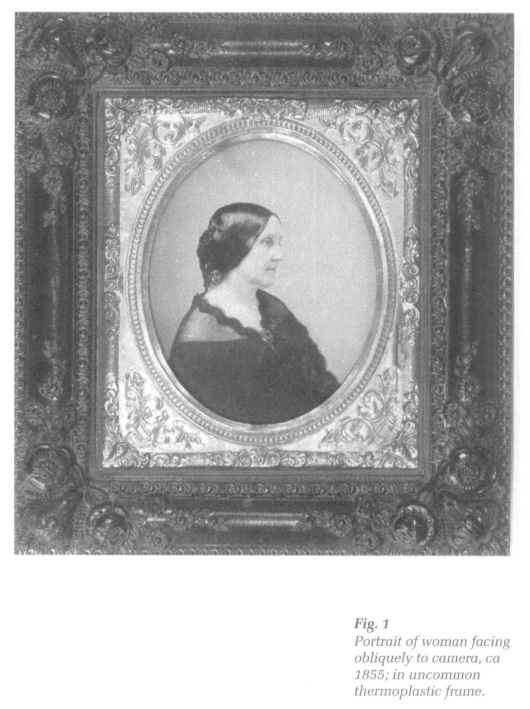 Display large image of Figure 1
Display large image of Figure 110 Readily and inexpensively manufactured, collodion had proven itself a superb emulsion support. The problem lay in its practicability on glass.23 The manipulation was reasonably complicated and since all operations had to be done on the spot, the outdoor photographer was particularly burdened with a complete portable darkroom. Exposure, a function of the len's rapidity as well as the size of the collodion plate, compounded the problem. Nevertheless in 1851, this new development so revolutionized glass-plate photography that it won over even the remaining enthusiasts of the on-paper system.
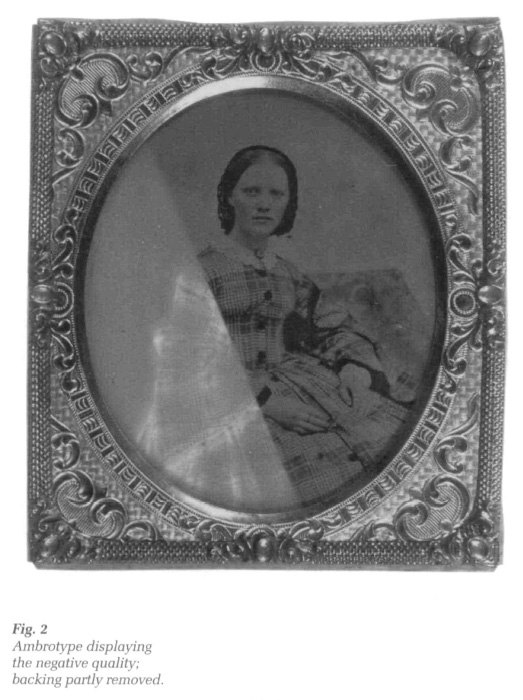 Display large image of Figure 2
Display large image of Figure 211 Following the publication of The Collodion Process on Glass in 1851, Archer, in collaboration with fellow Englishman Peter Wickens Fry, worked out the direct positive on glass variation (i.e., ambrotype). Underexposed collodion negatives were bleached during the developer stage with mercuric bichloride or nitric acid. This produced a seemingly positive picture when viewed by reflected light against a black background24 (Fig. 2).
12 Using Archer's published accounts photographer-experimenter Dr. Giles Landell of Boston procured "good collodion portraits on (black) paper" and called these "melanographs."25 They are technically a collodion positive on paper. Archer's invention, given freely to the scientific world,26 was patented in 1854 in the United States as the "Ambrotype" process by a Philadelphia daguerreotypist named James Ambrose Cutting. Cutting's patent protected the mechanical technique of sealing the image between two sheets of glass with Canada balsam. (It is therefore ironic that we identify the collodion positive process with the patentee rather than with the inventor who showed how collodion could be the carrier of light-sensitive chemicals.) The term "ambrotype" comes from the Greek word ambrotos meaning immortal or imperishable. It was proposed by Isaac Rehn, a painter-turned-daguerreotypist, who promoted Cutting's variant of the collodion-on-glass to Marcus Aurelius Root, who then suggested the term "ambrotype."27 It is only coincidence that Cutting's middle name was Ambrose. The first mention of the ambrotype by name occurs in Humphrey's Journal for 1 February 1855, as part of the description of Rehn's work at the fair of the Franklin Institute in Philadelphia.28 Cutting received one British and three American patents.29 His British patent covered the term "ambrotype" and the use of Canada balsam. Ironically there are no confirmed British ambrotypes sealed with the Cutting method.30
Ambrotypes in Canada's West
13 The introduction of photography into Canada's West is the result of a two-prong advance: eastern, government-led expeditions and independent photographers travelling westward; and migrant gold seekers heading eastward from the Pacific Northwest and neighbouring interior.
14 In the 1850s there was an increasing Canadian interest in the West. The Hudson's Bay Company's jurisdiction was coming to an end: American settlement was advancing westward. In 1857, the Province of Canada sent survey expeditions to establish an immigrant route between Lake Superior and the Red River Settlement. The following year government expeditions extended the survey further west to the foot of the Rockies to confirm Canada's expanding national border. Among the survey team leaving Fort Garry in 1858 was the young photographer Humphrey Lloyd Hime, who is credited with producing the first successful expedition photographs in the West.31 Undoubtedly cumbersome, the wet collodion process necessitated not only camera, tripod and glass plates, but also chemicals, a portable dark tent practical enough to travel by canoe, dog cariole or Red River cart! On location it was necessary to have at least a barrel of "clean" water, as almost invisible amounts of foreign matter in the silver nitrate bath would invariably result in a blank plate. The very lack of clean water ruined many of Hime's photos. The 1858 expedition supply records indicate a copy of T. Frederick Hardwich's indispensable A Manual of Photographic Chemistry Including the Practice of the Collodion Processes.32 There was no intent to produce ambrotypes during these early government-sponsored expeditions. Hime's work, as well as other, later, expedition photographic results, clearly served to produce prints for a variety of publications.33 It was not until the 1870s that various expeditions photographed the West again, but in the meantime other independent photographers travelled outwardly from the Red River Settlement.
15 The 1858 California gold rush and the 1861 Fraser River, British Columbia gold rush increased the demand for pictures as adventurers left for these distant Eldorados. Photographers were close behind. Stephen Allen Spencer, for example, arrived at Fort Victoria in 1858 and advertised as a "Daguerreian Artist" in 1859, but soon after called himself an "Ambrotypist and Photographist."34 Advertisements offered patrons the opportunity to procure ambrotypes of sick and deceased friends35- an interesting social practice carried out on this continent. On 14 February 1860, The Nor 'Wester (the first newspaper of the Canadian prairies, published 28 December 1859 until seized by Louis Riel in 1869)36 had an advertisement for "The Red River Portrait Gallery." The "likenesses" that the photographer, A. Barnard, was willing to barter for wheat, flour or wood,37 were probably ambrotypes. By winter the same gallery "had been refitted and offering ambrotypes, photographs, and melanotypes."38 Another (itinerant) photographer, D. R. Stiles, offered similar selections in St. Boniface, while staying at the American House owned by Mr. Charles Cavilier.39 In 1849, Joseph Langevin left Quebec to seek adventure and fortune. When the U.S. Civil War broke out, he served as an intelligence officer supplying information about Indian activities in the American Northeast. Somewhere along the way he apparently learned photography and by 1864 Langevin had set up his studio in the Red River Settlement "next door to Messrs. Higgins and Lyons."40The Nor'Wester appeared to have reviewed favourably his photographs (cartes de visite) and ambrotypes. Post-mortem images ca 1864-66 were also taken.41 He expanded both to Fort Pembina and into the Minnesota Territory.42 Several photographers worked in the Canadian West43 during the "ambrotype era" and we know they used the wet-plate process. Hudson's Bay Company records indicate that some employees "adopted photography as a pastime" during this era.44 We can only surmise as to who took the ambrotype of "Grandmother Rowland" in the late 1850s or early 1860s (Fig. 3).45
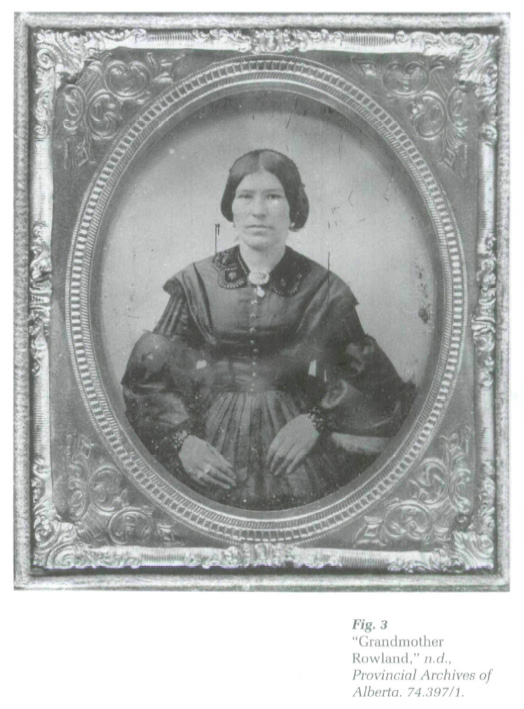 Display large image of Figure 3
Display large image of Figure 316 Whether established gallery owners or itinerants, few Canadian photographers used the wet collodion process other than for ambrotype portraits before 1860. Paper photographs were taken in the 1850s: large prints or stereographs are indeed rare.46 In established eastern centres the market for, and competition between, the daguerreotype and ambrotype was apparently fierce. Practitioners promoted the rapidity of their crafts, with daguerreotypists having a temporary edge.47 Wet collodion photographers reported that it took 20 seconds of exposure time in a gallery under ideal conditions whereas (by mid-1850s) the daguerreotypist ordinarily required just 2 seconds.48 Fresh emulsion provided speeds equal or close to that of daguerreotypy; however, with posing and other delays the wet plate dried, becoming slower in its response to light and even completely insensitive. In either practice there are few "candid" or "instantaneous" photographs49 (Fig. 4). As a general rule, the larger the "plate" size, the longer the exposure — a function of the existing optical properties of the cameras.50 The slow exposure precluded the need for a shutter mechanism. Photographers simply uncapped their lenses to expose the plate.
17 By the latter 1850s the ambrotype had superseded the daguerreotype in Canada both in popularity and convenience.51 Canadian examples are unfortunately very hard to confirm as many were encased in either American-made papier-mâché, thermoplastic "Union" cases or frames, or European-supplied papier-mâché or leather cases.52 The more important Canadian galleries occasionally stamped, or had their cases stamped with, the studio name but the author is unaware of this practice out West. Trade (business) cards, occasionally sandwiched inside the case, were often misplaced or lost. (These must not be confused with the case manufacturers' advert and patent notices.) Some studios pasted a small label directly on either the mat or preserver (Fig. 5) or a larger patch on the felt. The problem is compounded by itinerant photographers who chose not to protect their work in such cases. Understandably, unprotected (i.e., uncased) ambrotypes have a greater chance of being damaged or destroyed. It has been suggested that during the early years daguerreotype cases were used, but as ambrotypes became popular, cases were specifically made to accommodate the deeper, double-thickness glass (i.e., Cutting process).53 The circumventing of the unpopular patent makes this doubtful (see Appendix A). Inspection of cases also does not confirm this nor has the author come across supporting period literature. The author is aware of "Brady two-way open cases" manufactured to demonstrate the negative-positive (transmitted light-reflected light) nature of ambrotypes not coated with an opaque backing (see Appendix A, "aesthetic variations"). Insect infestation has always been a problem and a common reason for transferring images from one holder case to another, in several instances resulting in some damage.
18 By the early 1870s more light-sensitive gelatin dry plates travelled into Canada's West.54 Most studio and itinerant photographers ceased to work with the old wet-plate technology. The pre-sensitized dry plates eliminated the need for awkward chemical procedures and the new sensitized papers all but ended the old chemical technology. The ambrotype had become outdated.
Applied Colours — Rosy Cheeks and Healthy Appearances
19 From the moment the first image appeared the marvel of the new technology was tempered with the disappointment that nature's colours were not recorded. Almost immediately various methods were developed to mimic real colour.
20 Collodion-on-glass images were considerably easier to hand colour than were the daguerreotypes.55 The ambrotype's collodion accepted a variety of dry and wet materials. For a fee, the ambrotype could be coloured by an artist or the photographer himself, who would apply either dry powdered pigments, or oil- or water-based paints, to the underlying monochromatic image.
21 Very few present-day photography books discuss these application techniques. One must rely on period literature for details; among them The Photograph and Ambrotype Manual (1858) by N.G. Burgess of New York56 or Harmonious Colouring as Applied to Photography (1859) by James Newman of England.57 Dry pigments were carefully applied onto the collodion. The excess was gently blown away with a fine rubber air bulb and a suitable transparent varnish was applied. Once the varnish was dry, extra colour could again be applied.58 "Wet" colours, that is, oil- and water-based paints, required some knowledge in colour. Simply mixing the colours to the desired hue and then washing them onto the collodion rarely ended in success. The photographer had to remember that in some instances the collo-dion gave a "base" colour (e.g., apply pink to a grey base and you get purple). The end result was strictly a function of the artisan's expertise and hand. Jewelery (lockets, necklaces, brooches, etc.) were invariably painted over with gilt. In several examples jewelery is painted in where none existed! Both "dry" and "wet" paints were available in a variety of kits.
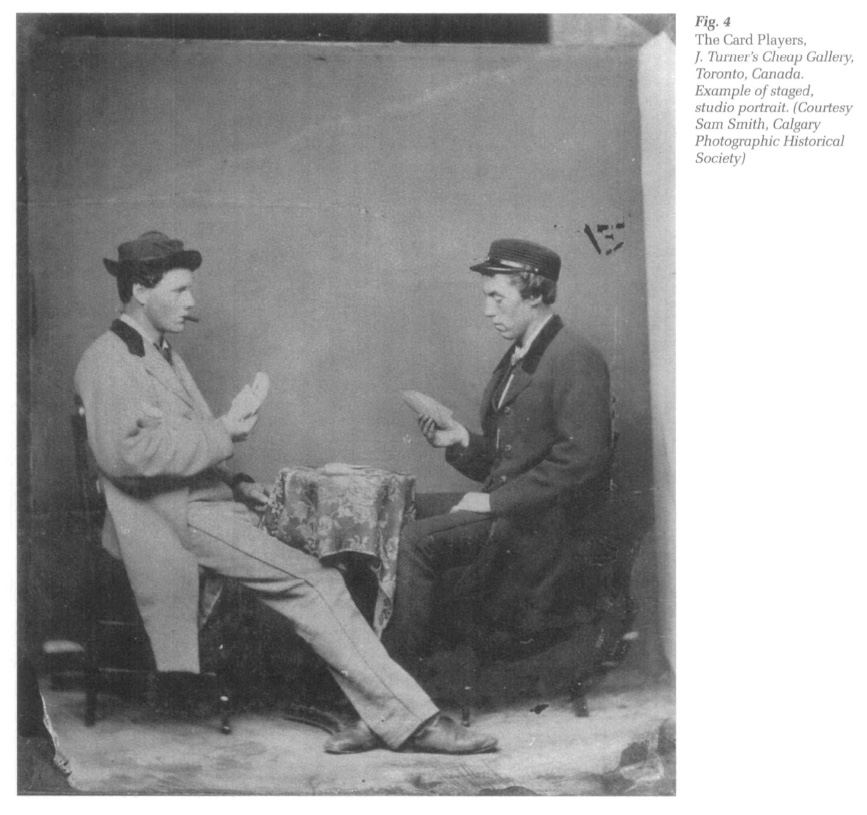 Display large image of Figure 4
Display large image of Figure 422 To protect this handiwork, many photographists chose to apply clear varnishes over the hand-coloured collodion. Clear varnishes were based on natural gums such as copal, demmar and amber, which did not require plasticizers.59 For the itinerant photographer such varnishes became economical substitutes for the protective holders and frames.
23 To bring out the "positive" aspect, the photographer gave the glass plate a final dark lacquer or inserted dark paper, metal or fabric directly to the collodion suface or directly to the reverse side. On occasion one notices the use of the "relievo process" (Fig. 6) (see Appendix A for explanation and variants).60 A vast majority of ambrotypes are found encased.
24 With few exceptions excellent results came from established studios while the itinerant ambrotypist rarely coloured the image or produced garish results. Ambrotypes on ruby glass have occasionally faint colouring — mostly on facial features — but with mixed results. On rare occasions ambrotypes are found with applied colours to the reverse (non-collodion) surface of the glass, and care must be taken not to accidently remove them. If painted on the backdrop, these colours produce interesting pseudo-stereoscopic effects. If the colours are painted on subjects, particularly the facial features, the results are awkward.61
A Brief Comment About Care and Preservation
25 It is not the purpose of this paper to discuss conservation, however readers should be made aware of some concerns.62 Preservation of any item is essential for future generations to enjoy. The pros and cons of any type of treatment should always be considered beforehand. Traditional conservation standards mandate that nothing be done to a piece that might damage or alter it. Ideally, a treatment should be reversible, that is, you should be able to undo it without damaging the image. This begins with the very act of removing the image from its casing. Readers of care and restoration literature should remember that while much research has been carried out, particularly this past decade, some practices described in even recent publications are outmoded or questionable. "Revarnishing" the back of ambrotypes with black lacquer is a perfect example of an ethical problem. "Rewaxing" a protective case is another. When trying to come to a qualitative judgement about ambrotypes, it is important to examine as many as possible. If in doubt, contact an experienced conservator.
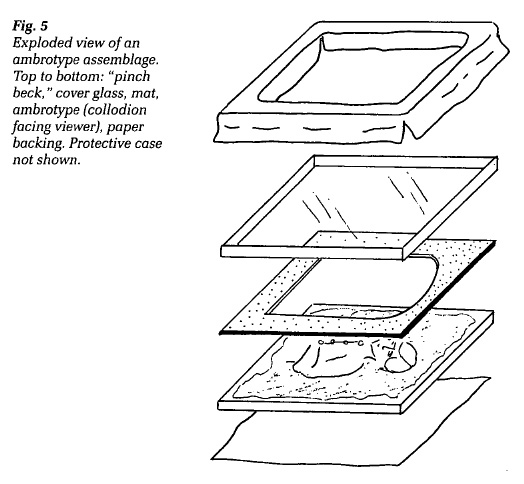 Display large image of Figure 5
Display large image of Figure 526 The emphasis should be on the identification of problems, common-sense care and basic preservation techniques, including documentation - a topic often neglected or ignored entirely. Cleaning and restoration require a hands-on approach under controlled supervision and all artifacts should be handled with lint-free, non-slip gloves. The author suggests that a photographic copy of the original be made as early as possible. Surrogate images are the safest materials. They can be handled with less concern, and if destroyed a new copy can be made from the stored negative.
Conclusion
27 Until recently, nineteenth-century photographs mostly mouldered away in attics and antique shops. Today collecting old pictures is as popular with museums as with private collectors — and with good reason. Old photographs provide rare visual documentation of a country growing up. There is great satisfaction in discovering or identifying important material relating to western Canada. The interest in old photographic techniques has in the past 15 years created a "modern" revival in their processes. Daguerreotypes, ambrotypes and "tin-types" have all been produced. These create fascinating results with a contemporary view of photography. Some images are surfacing, however, with a clear intent to deceive the public and unknowledgeable collectors. It is almost impossible to "fake" sites in Alberta (in part due to relatively recent exploration and the total absence of the early forts and other structures), but the eastern half of North America has fallen prey to unscrupulous dealers. Caution is advised, particularly where provenance is sketchy about images "too good to be true."
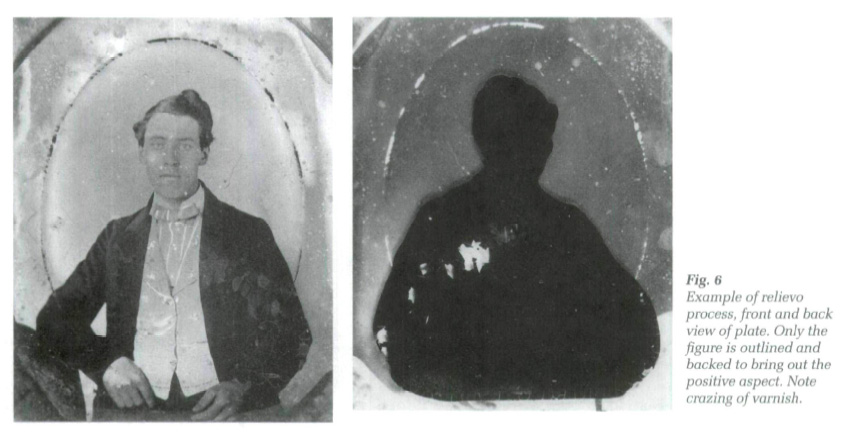 Display large image of Figure 6
Display large image of Figure 628 Ambrotypes are clearly underrated and those with occupational or thematic subject matter should be avidly sought. Those proven to represent early prairie work must be located. The question is, where have they gone? The ambrotype of "Grandmother Rowland" taken at Fort Edmonton is presently the only confirmed prairie example (Alberta region) to the author's knowledge. Considering the large numbers of ambrotypes extant in western Canada, greater research must be carried out to check for clues attesting to their provenance. There has been extensive research on a photographic predecessor, the daguerreotype, and on the dry plate, which followed wet collodion imagery. It is time we paid attention to the use of ambrotypy on the Canadian plains.
Appendix A — Varieties of Collodion Positives on Glass (Ambrotypes)
a) Ambrotypes on plain glass, with "backing" on emulsion (collodion) side
29 Backing can be any of the following: 1) black varnish; painted directly on emulsion; or on a second pane of glass (Rehn); 2) velvet (dark colours, mainly black, though mauve and blue have been observed); 3) black paper or cardboard; 4) metal sheet or foil, painted black.
30 No specific dates (1854 to ca 1870). Comprises the majority of ambrotypes found. The process existed in several variants. Depending on the chemical treatment, the image colour can range from the normal creamy colour to a silvery white or even to a snow-white - a result known as alabastrine. Conventional gradations of the collodion include white to silver to light grey to dark grey to "pale" black. The collodion itself may or may not be protected with a transparent lacquer. (N.B., if backing is on collodion side then the image is laterally corrected for viewing. However, to improve "viewing" and to bring out detail, many photographers preferred to reverse the image and varnished the non-collodion side.)
31 Other "aesthetic" variations include the following: 1) relievo process, ca 1854, by Urie, British; revived by T. C. Lawrence in 1857; due in part to the popularity of stereo pictures. Only the subject matter, collodion side, is varnished black; the rest of the emulsion may or may not be scraped off; 2) white (see "white ambrotype" below), coloured or painted backing papers are set behind the plate; on rare occasions a domed cover glass is substituted to further enhance the relief aspect (compounded by the collodion's shadow casting to the backing, if collodion nearest to viewer); 3) lampratype, by S. A. Holmes, American; "strategic" buffing of collodion surface with an oiled/ greased buckskin or similar material imparted a sheen and contrast to the pale and dark tones-the transparent areas became clearer, the highlights denser. A fine brush or camel's hair pencil was used to accentuate details. The collodion may or may not be shellacked with textile material adhered to it.
32 To demonstrate the negative-positive (transmitted light-reflected light) appearance the image is sometimes found in "double-case" or "Brady two-way open case." This will only apply to images without the varnished backing.
b) Ambrotypes on plain glass but collodion sandwiched by second clear glass permanently secured to collodion with balsam of fir (Canada balsam) (better known as Cutting process)
33 Based on American patent obtained in 1854 (shortlived, until 1858, circumvented by several patent objectors); derivatives include "improved ambrotypes"; varnish applied to collodion side, backing on same side; also "Simmons variation" whereby any varnish other than balsam of fir is used.
34 All "Cutting" ambrotypes and variants are prone to air bubble inclusions when the two glass plates are cemented together. (Careful not to confuse with gas inclusions on glass plate proper.) Unless chemical tests are carried out it is impossible to determine which variant is present.
c) Ambrotypes on ruby or coral glass (term used interchangeably for either deep red, mauve or burgundy glass; on rare occasions "bottle" brown; beginning ca 1857, used sporadically until 1870); also on blue "Bristol" glass (England only, rare)
35 These ambrotypes required no backing as the glass was already very dark; sometimes found in "double case" or "Brady two-way open case," the viewer would point the case toward any light source and see (usually) deep red background with a "negative" image. A variant: background is scraped away leaving only the subject (but is not relievo).
d) Ambrotypes on plain glass, with a "white" (painted or paper) backing
36 Known commercially as "white ambrotype," only the shadow areas (i.e., portrait or subject matter) of the collodion are saved; the rest of the collodion (i.e., the backdrop) is scraped away; a full white backing is used, providing the effect of a photograph on milk glass; this is a variation of relievo process.
Appendix B — Other Wet Collodion Positive Derivatives
My sincere thanks to several people for their assistance. First and foremost to Brock Silver-sides, friend and fellow enthusiast, Chief Archivist (Audio-Visual and Technical Services) at the Provincial Archives of Alberta, Edmonton, who brought to my attention additional research material, the existence of "Grandmother Rowland" (reproduced herein by kind permission) and who offered concrete comments. Several staff members from the Glenbow Museum, Calgary, also provided invaluable assistance. They include the ever-questioning Sarah Joyce, Head of the Conservation Department, who together with other staff members provided insight into the complexities of conservation research; Lynette Walton, Archivist at Photo Archives, who graciously made available the Glenbow's collection for comparative stuthes; and last but not least, Catherine Myhr and Lindsay Moir of the Library and Archives, both of whom cheerfully located reference material. Thanks also to Sam Smith of Calgary Photographic Historical Society who provided the ambrotype of the card players. All other ambrotypes are from my private collection.